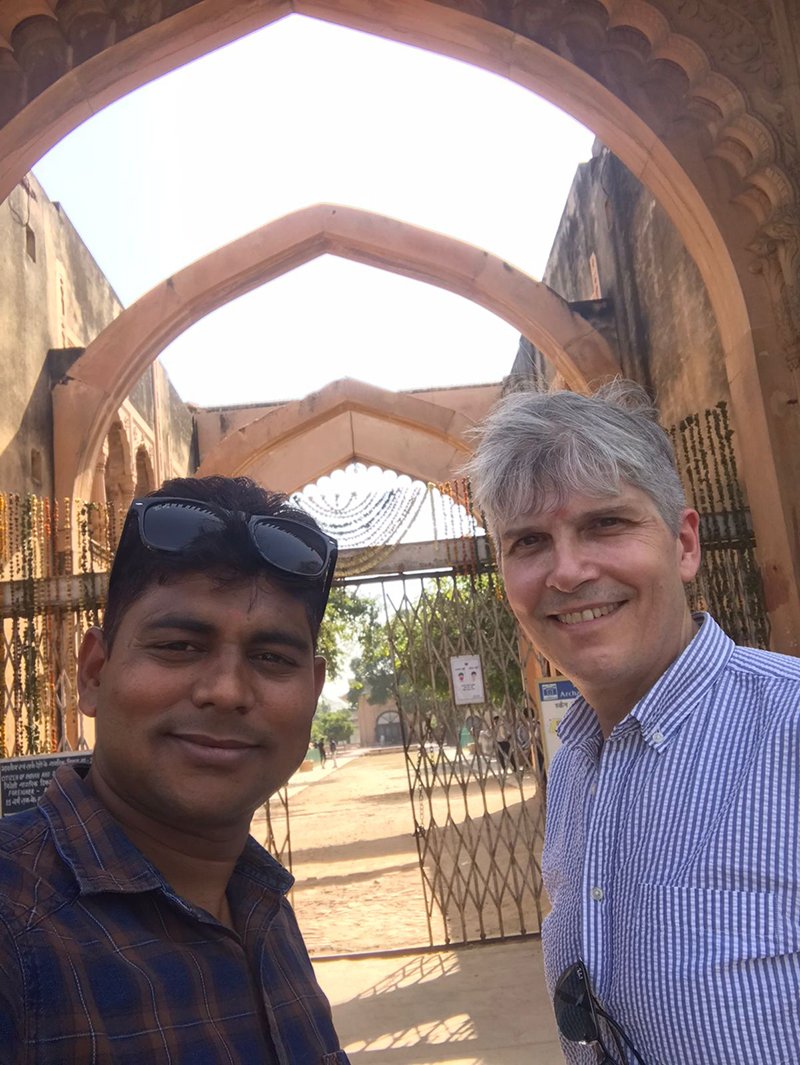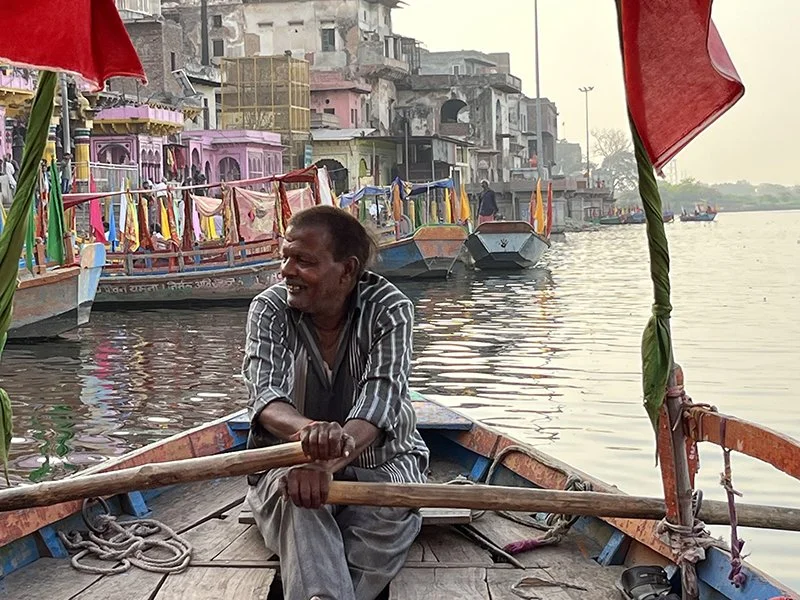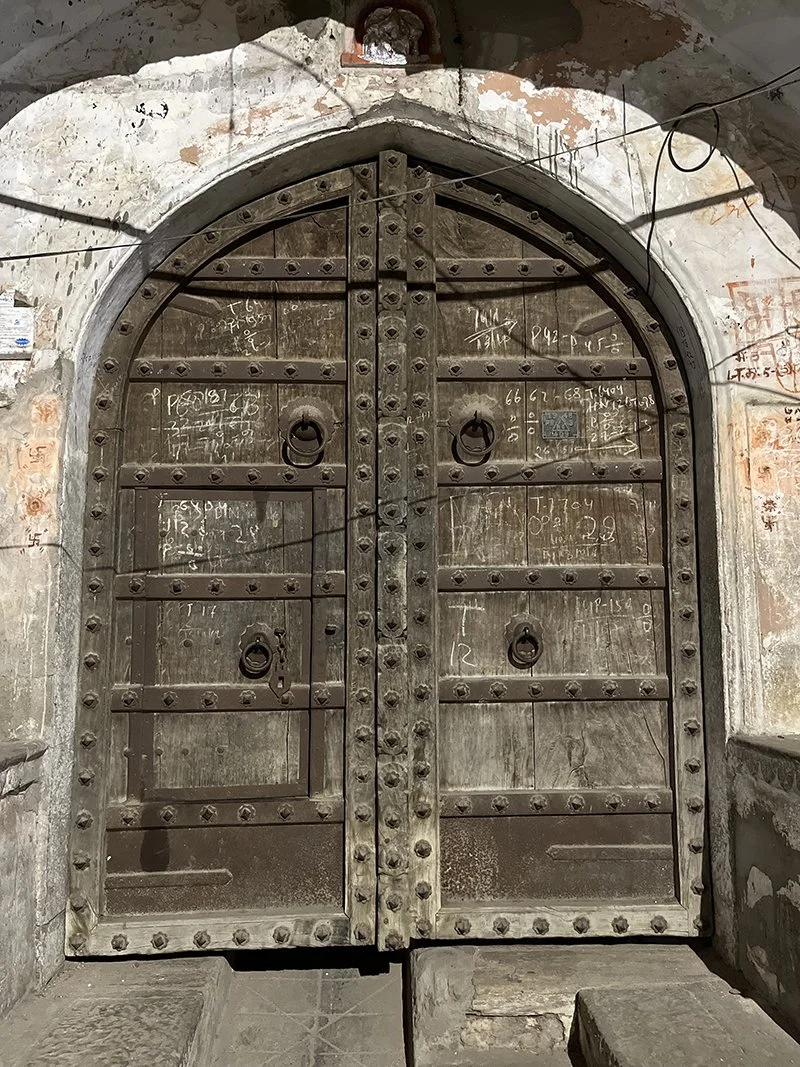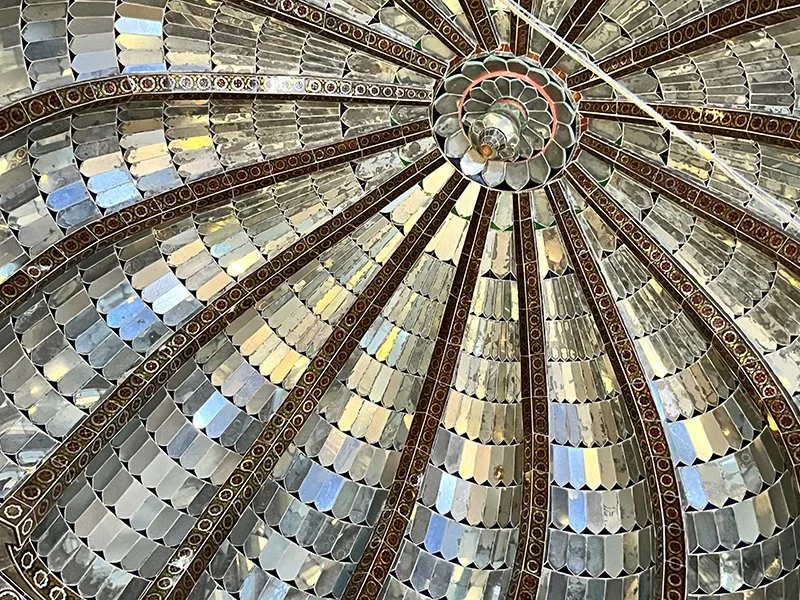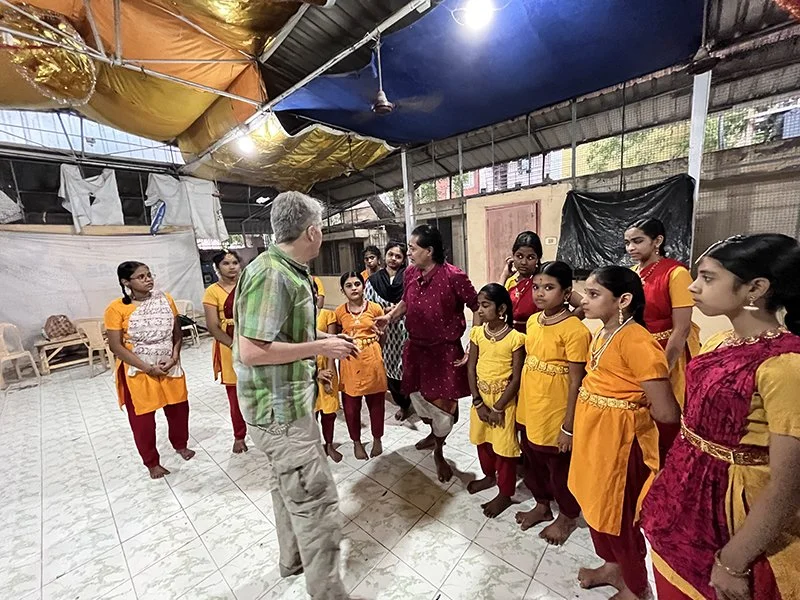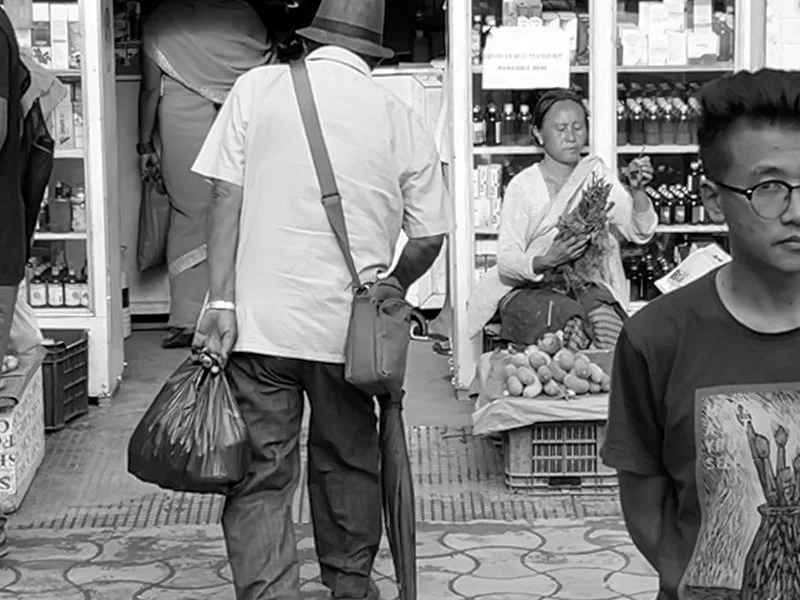Exploring the Visual Cultures of India Through its Art, Performance and Ritual
Les Joynes, PhD, Scholar on the Futures of Culture in Public Diplomacy, 2022 Fulbright-Nehru Professional and Academic Excellence Award and Senior Scholar, Indira Gandhi National Centre for the Arts, New Delhi; Visiting Professor, Visva-Bharati University, West Bengal.
Greetings.
This is an ongoing photo documentation of my Fulbright Research Fellowship in India in 2022.
I am an American artist and research scholar on US multilateral exchange in the arts and culture and serve as a professor of American Modern and Contemporary. My Fulbright experience in India was the culmination of four years of preparatory research at Columbia on Indian dance, religions, histories and education.
In February, 2022, I posted as Senior Scholar at the Indira Gandhi National Centre for the Arts and had the opportunity to examine art, performance and creative heritages in India, lecture on site-specific art, lead workshops on mural design, and organize a symposium on curriculum design and the future of museums and curate an exhibition in New Delhi. I also initiated my new series of performances inspired by Indian classical performance and prepare return projects in Kerala, Mumbai, Kohima, and Colombo.
One of the most extraordinary places, I visited is Nagaland, a state in India’s northeast near Assam and the border with Myanmar. As a newly elected member of the Highland Institute, I set to work with local groups to founded the Naga Youth Mentoring and Coaching Program which focuses on supporting the Naga tribal communities in career, education and health. I also examined how art and cultural exchange can play expanded roles - enhancing mutual understanding and shaping the future of public diplomacy.
During my Fulbright fieldwork, I traveled from Delhi to Uttar Pradesh, Rajasthan, Maharashtra, Kerala, Tamil Nadu, Andhra Pradesh, West Bengal and obtained special permission to visit Nagaland in India’s Northeast border with Myanmar.
In each area I examined social structures, sites and the performative body (including rasa expressions of love, compassion, wonder, humor, peace, heroism). Indian performative traditions that are at the foundations for Western and Eastern aesthetics - and traditions that have shaped histories of the South Asian performative body from pre-history to present.
Before during and after my Fulbright experience, I learned the power of building networks. In preparation for my posting I built connections with past Senior Scholars in India and initiated my connections in country with academic networks, Fulbright regional offices, the Indira Gandhi National Center for the Arts offices, the Royal Asiatic Society as well as my local government hosts. This experience has inspired me to continue to build connections in South Asia and I am currently preparing a solo exhibition in Kerala, guest lecturing in Mumbai, a Coaching and Mentorship program for Tribal Communities in Nagaland, and an art biennial and US-Sri Lankan bilateral project in Colombo.
In February 2022… it began in New Delhi….
Fulbright headquarters in India: The United States India Education Foundation in New Delhi. My research and travels began here as one of the first Fulbright Scholars to come to India after Pandemic. I was prepared to travel in September 2020. The Fulbright was delayed five times until I was posted at the beginning of February, 2020.
The Red Fort in New Delhi. Founded by Emperor Shah Jahan and surrounded by a magnificent 18m-high wall, this fort took 10 years to construct (1638–48) and is rumoured to have had the decapitated bodies of prisoners built into the foundations for luck. It once overlooked the Yamuna River, which has now shrunk to some distance away.
Sunset at Humayun’s Tomb in New Delhi.
At Humayun’s Tomb in Delhi chatting with university students from Delhi University.
The colossal Humayun Tomb of the Mughal Emperor Humayun in Delhi which was constructed 1547 on the banks of the Yamuna River. Located in Nizamuddin in Old Delhi it is the first garden-tomb on the Indian subcontinent, As an example of Mughal architecture, the tomb is modelled on Gur-e Amir in Samarkand.
A visit to the Nizamuddin Mosque to hear the Thursday Qawwali Nights At Delhi's Nizammudin Dargah.
Three weeks into my Fulbright I went for my annual physical checkup and discovered that my gallbladder needed to come out. I had a successful procedure at Max Hospital in New Delhi performed by Dr Pradeep Chowbey - surgeon to the former President of India and to the Dalai Lama. I was briefly in the hospital and two days later was lugging my backpack onto trains as I headed to Uttar Pradesh and Rajasthan.
The Journey Begins: Uttar Pradesh - On the road to Mathura and Vrindavan
In Mathura with my driver, guide and friend, RP, visiting the Forts on the way to Mathura.
Vishram Ghat, located about 5km from Mathura, which is the center to 25 ghats. According to legend, Lord Krishna rested at this place after killing the evil demon. It is popularly known as the heart of Brij Bhoomi, the land and birthplace of Lord Krishna.
A short boat ride on the Yamuna river in Mathura. According to the legends, Yamuna was the daughter of Surya, the Sun God, and sister to Yama, the God of Death and thus the popular belief have come up that those who take a dip in its holy waters are not besieged by fears of death. The Yamuna river is closely connected to Lord Krishna's childhood days. ike the Ganges, the Yamuna River is highly venerated in Hinduism in the form of a river and as the goddess Yamuna. The Yamuna is considered a river of heaven. The Rig Veda includes the Yamuna River as one of the seven sacred rivers, along with the Ganges.
Breakfast of Champions at MVP Hostel in Vrindavan near ISKCON.
Having tea with workers while visiting Shrivatsaji, the head priest of Radha Raman Temple in Vrindavan. Krishna spent most of his childhood days in this city.V rindavan has about 5,500 temples dedicated to the worship of Krishna and his divine consort Radha.
Interviewing Srivatsaji and talking about the elusive meaning of happiness in different cultures.
The Rasalila takes place one night when the Gopis of Vrindavana, upon hearing the sound of Krishna's flute, sneak away from their households and families to the forest to dance with Krishna throughout the night, which Krishna supernaturally stretches to the length of one kalpa, a Hindu unit of time lasting approximately 4.32 billion years. In the Krishna Bhakti traditions, the rasa-lila is considered to be one most beautiful depiction of soulful love. In these traditions, romantic love between human beings in the material world is seen as a reflection of the soul's original, ecstatic spiritual love of Krishna, in his spiritual world, Goloka.
Vrindavan, Uttar Pradesh. Holi begins…The essence of the festival holds that throwing colours during Holi symbolizes the burning away of sins and clearing out negative thoughts such as anger, hatred, jealousy, and suspicion. One legends is Holi originates from Hindu mythology, with the legend of Hiranyakashyap which tells us of the megalomaniacal Demon God Hiranyakashyap’s wish for everyone around him to worship him as God, only for his son, Prahlada, to refuse. Prahlada devoted himself to the God Vishnu, known as “The Preserver.” Vishnu was deeply impressed by his rebellion against evil and ultimately killed the demon king, Hiranyakashyap, after saving Prahlada from a burning fire started by his own father. Another Hindi legend spoken of during Holi is the tale of Lord Shiva and Kamadeva, the God of passion, the latter of which woke Shiva from deep meditation in order for him to save the world.
Jaipur…Holi begins.
The Zenana built from red and pink sandstone, the Hawa Mahal (1799) was built by Maharaja Sawai Jai Singh, founder of Jaipur displays here the five-floor honeycomb exterior and 953 small windows called Jharokhas decorated with intricate latticework that was constructed to allow royal ladies to observe everyday life and festivals celebrated in the street below without being seen.
Entering the City Palace in Jaipur.
The City Palace area at sunset.
An a visit to a Hindu Temple all in white marble.
Then to the Albert Hall Museum…
The magnificence Albert Hall Museum in Jaipur. Named after HRH King Edward VII (Albert Edward) (1841-1910) who ruled from 1901-1910. A classical British example of museums that portray culture, science and industry as well as merging the architectural styles prevalent in Great Britain with those of India. Albert Hall was designed by Samuel Swinton Jacob, assisted by Mir Tujumool Hoosein, and was opened as public museum in 1887.
An extraordinary example of a nineteenth century Norton turnstile still in operation. No rushing the barriers here!
As a practitioner of Ashtanga Yoga, I appreciated these clay figurines of Yogi’s from the 19th century - perhaps to serve as examples of different forms of Yogic practice in India.
On my trip to the great Amer Fort in Jaipur, I was advised to meet a Mr. Bhat, the head of a brass band famous in the region. I met his Brother who introduced me to his family, his parents and most of his community who assembled in an area called the Artist Colony in Jaipur for a local wedding - a big event for everyone as Pandemic had made public events very challenging.
There were about 30 kids attending the wedding event and they were excited to see a foreigner after two years - and I may have been the first American they had met. I asked them what their favorite film was an amidst shouts of “Spiderman, Batman, Captain America!” the bride and her entourage arrived and we had to quickly restore order so the wedding could proceed.
Preparations for Rajasthan Day - the national Day in Rajasthan on 30 March 2022. Under the protection of giant tents in the blazing sun - performers from all over Rajasthan assemble to practice for the televised national celebrations that take place on a giant stage erected in front of the Albert Hall Museum.
Puppet master apprentice.
Dancers
Preparing the entry for the horse dancers…
Puppeteers practice alongside
And I am given a try at puppeteering.
The horse dancers arrive….
Kachchhi Ghodi dance originated in the Shekhawati region of Rajasthan. Dancers wear novelty horse costumes, and participate in mock fights, while a singer narrates folk tales about local bandits. In Rajasthan, the dance is performed by men dressed in a kurta and a turban, along with an imitation horse costume.[3] The shell of the costume is constructed out of papier-mâché molded to resemble a horse supported by a bamboo frame. It is then covered with bright colored fabric elaborately designed with mirror-work embroidery known as Shisha. Around the ankles, the dancers wear musical bells known as ghungroo, similar to those worn by Indian classical dancers.[citation needed]
Bagpipers
[Video] Rajasthani performers in Jaipur during the practice sessions before Rajasthan Day in 2022.
https://vimeo.com/769873737
Rajasthan Day, Albert Hall Museum on March 30th 2022. When performance becomes Heritage and Heritage becomes spectacle.
A tranquil walk on the quiet streets parallel to the markets near the City Palace in Jaipur.
Taking the train 2AC from Jaipur to Udaipur.
Plenty of space for the next nine hours.
Two floors to enjoy.
And finally - at the end of a long journey arriving in Udaipur.
Udaipur
Ritual and Performing Spring. A woman wearing Ghagra Choli performing Gangaur Puja where she presents a temple idol to Gangaur Ghat on Lake Pichola at the feet of the City Palace in Udaipur (4 April 2022), one of the festivals of Rajasthan that celebrates the worship the Goddess Parvati (2022© Les Joynes).
Kerala April 2022
[Image] Observing and Documenting Performance: Thrissur Pooram is one of India’s largest Hindu Festivals in the 10 temples situated around Vadakkunnathan Temple. More than 100,000 in attendance. (2022© Les Joynes). I was welcomed as a member of the press to attend the central performances.
Observing Kootiyattam Performance of Margi Madhu School in Central Kerala 2022 (2022© Les Joynes)
Chennai, Tamil Nadu, June, 2022
At the Madras Club, home away from home.
Bronze Ganesh at the Government Museum, Chennai which since 1851, is the second oldest museum in India and has the richest collections of bronze idols, 500 of them dating to 1000 BCE, in Asia
13th century bronze sculpture of Uma.
13th century bronze Nataraja from the Queida Milla District, Tamil Nadu.
The theater dating from 1851 was under renovation and I had a chance to roam around inside.
The Parthasarathy Temple is a 6th-century Hindu Vaishnavite temple.
The gopuram (towers) and mandapas (pillars) are decorated with elaborate and almost contemporary carvings.'Parthasarathy' means the 'charioteer of Arjuna', referring to Krishna's role as a charioteer to Arjuna in the epic Mahabaratha. Inside are shrines for Vedavalli Thayar, Ranganatha, Rama, Gajendra Varadar, Narasimha, Andal, Hanuman, Alvars, Ramanuja, Swami Manavala Mamunigal and Vedanthachariar.
A visit to meet the director of the Kalakshetra Foundation which was was established by Rukmini Devi Arundale and the theosophist George Arundale and since 1936 was the hub of the best teachers, musicians and performers. It is one of the sites for my future research in India.
I had a Fulbright research visit to the Madras Kali Bari Temple, is a Hindu temple in the neighborhood of West Mambalam in Chennai. Here I met with students and parents and spoke about Bharatnatyam, a devotional dance form and its training for young students.
Discussing Baratnatyam - both performance and devotion. And a unique form of education in India.
Nagaland, August 2022
I arrived in early August - overcast - the town of Kohima is settled atop a mountain ridge. Originally known as Kewhira, Kohima was founded in 1878 when the British Empire established its headquarters in the Naga Hills District - then Assam Province. It officially became the capital after the state of Nagaland was inaugurated in 1963. Kohima was the site of one of the bloodiest battles of World War II. The battle is often referred to as the Stalingrad of the East.
I was hosted at a house down a meandering mountain path 200 meters down the hill. So deep in the clouds that the clouds would roll in the windows of my homestay.
Houses are built to be pierced on the hillsides.
A sweeping view from the Kohima National Museum.
The museum which houses Naga artifacts.
Walking from the museum one encounters the growing town of Kohima dotted with homes and churches.
A bus takes me “down town” to the main market.
From the bus window I can take some photos.
[video] Interviews with Tetseo Singers (Mütsevelü Tetseo (Mercy), Azine Tetseo (Azi), Kuvelü Tetseo (Kuku) on right and Alüne Tetseo (Lulu) on left from the Chakhesang tribe of southern Nagaland- who demonstrating Li kukre kutiko (songs of the people), often performed in tribal competitions across valleys traditional (2022© Les Joynes)
Nagaland is 92% Christian and I had the opportunity to meet with several of its church leaders.
The diversity of Nagaland with its sixteen major tribes: Angami, Ao, Chakhesang, Chang, Dimasa Kachari, Khiamniungan, Konyak, Kuki, Lotha, Phom, Pochury, Rengma, Sangtam, Sumi, Tikhir, Yimkhiung, Zeliang.
With my new colleagues at the Highland Institute, Nagaland’s leading independent institute researching Naga culture.
A sunday walk near my homestay,
Meeting with local inhabitants and their collections of artifacts.
With my guide visiting tribal areas in the south.
With one of the Naga elders in Kohima receiving an honorary scarf.
Visva Bharati University, Santiniketan, West Bengal September 2022
Leading a workshop on mural design with MA and BA students at Visva Bharati University in Santiniketan in West Bengal,
University of Visual and Performing Arts, Colombo, Sri Lanka
Workshop on Performance. Visit to the University of Visual and Performing Arts in Colombo on a special Fulbright SCA-RTP Regional Grant to Sri Lanka.
More to come soon! Thanks for checking in! All the best for a terrific 2023! Les









